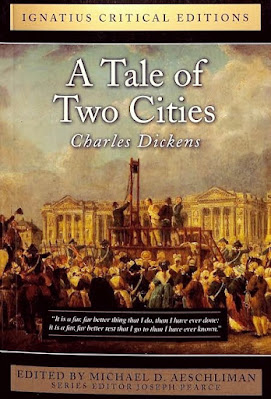Also Read
The background and the main subject of A Tale of Two Cities is the French Revolution and in this, Charles Dickens was inspired by Thomas Charlie's book the French Revolution. Dickens has integrated private lives with this dramatic and historical event. It is a novel about historical event and personal tragedy. As such it is an expression of Dickens view about the French Revolution. The private lives of the characters mirror the revolution and there lives a mirrored by it.
Though Dickens highlights the social and political events, he is of the opinion that mesmerized and bloodshed can never be supported. The solution lies in moral regeneration and not social and political uprising. In A Tale of Two Cities Charles Dickens delineates the exploitation of poor by the aristocracy, and the subsequent fairy of the revolution who executed similar evil deeds to take revenge. The novel is full of nightmares and melodramatic scene related to the bloody revolution. Dickens focuses on the mass butcheries, the injustice, the blood thirsty mob, the sharpening of weapons at the grindstone, the guillotine, heads falling off under the sharp blade, Sinistral old woman knitting the reign of terror are vividly portrayed as Monsters and inhuman.
By focusing on the causes and ugly aspect of the revolution, Dickens tries to highlight the meaning horror of the revolution, showing it to be Monsters, inhuman and unjust. Through this negative of the French Revolution Dickens scenes to be warning England that poverty and suffering in England due to the industrial revolution can also lead to a Revolution like the one in French. Dickens, basically a humanitarian, known that there is no end of tyranny and cruelty and he stands by the poor, against revolutions and revolutionaries as bloodshed and vengeance are there mean motives.
Thus we see that Charles Dickens is not a revolutionary. Though he feels that the revolution is a natural consequence of social oppression. He does not approve of the violence as he feels it is self destructive in the ultimate analysis, Dickens shows in the novel that sacrifice and compression is the answer to hatred and violence, oppression and cruelty.
 |
| A Tale Of Two Cities |
Though Dickens highlights the social and political events, he is of the opinion that mesmerized and bloodshed can never be supported. The solution lies in moral regeneration and not social and political uprising. In A Tale of Two Cities Charles Dickens delineates the exploitation of poor by the aristocracy, and the subsequent fairy of the revolution who executed similar evil deeds to take revenge. The novel is full of nightmares and melodramatic scene related to the bloody revolution. Dickens focuses on the mass butcheries, the injustice, the blood thirsty mob, the sharpening of weapons at the grindstone, the guillotine, heads falling off under the sharp blade, Sinistral old woman knitting the reign of terror are vividly portrayed as Monsters and inhuman.
By focusing on the causes and ugly aspect of the revolution, Dickens tries to highlight the meaning horror of the revolution, showing it to be Monsters, inhuman and unjust. Through this negative of the French Revolution Dickens scenes to be warning England that poverty and suffering in England due to the industrial revolution can also lead to a Revolution like the one in French. Dickens, basically a humanitarian, known that there is no end of tyranny and cruelty and he stands by the poor, against revolutions and revolutionaries as bloodshed and vengeance are there mean motives.
Thus we see that Charles Dickens is not a revolutionary. Though he feels that the revolution is a natural consequence of social oppression. He does not approve of the violence as he feels it is self destructive in the ultimate analysis, Dickens shows in the novel that sacrifice and compression is the answer to hatred and violence, oppression and cruelty.